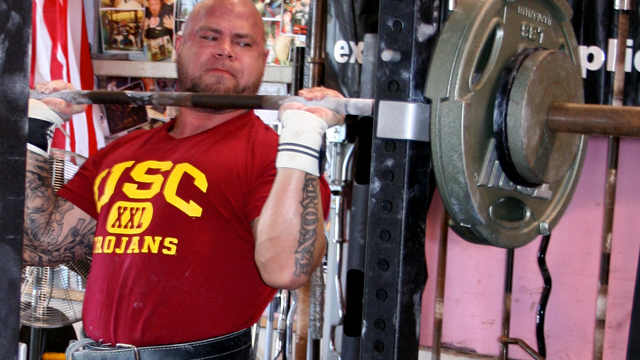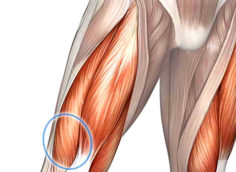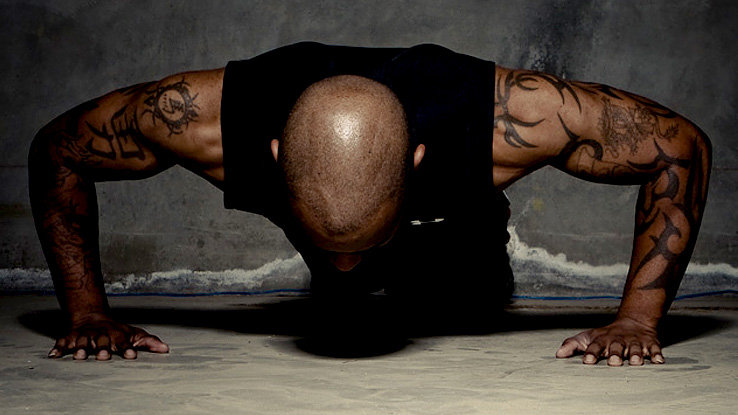Jim, what are three plyometric moves everyone should be doing?
There's been a lot of confusion about the role of jumping, throwing, and different explosive movements in training. It's reached the point that no one seems to be "ready" for them. Some experts have deemed that a lifter must achieve a certain level of strength in the main lifts (double bodyweight squat for example) before embarking on any type of jumping program.
Apparently, this rule does not apply to my 7-year-old son and his classmates at recess, or they just choose to ignore it as they run, hop, and jump until the bell rings. Perhaps in 10 years, my son will read these experts and become, like many, totally paralyzed in training. But not if I have anything to say about it. So let's clear some things up now.
First, unless you're terribly obese, have no coordination, and/or play World of Warcraft your entire life, you can jump. If you're reading T NATION, you probably can jump better than the average mouthbreather. You may not be fielding offers for track and field scholarships, but you can do it.
If you still doubt that you can, please expect more from yourself. Seriously. Doctors put animal hearts into humans to allow them to live, so I don't think it's asking a lot that you get a little air under your feet.
Second, your jumping programing doesn't have to be "Russian" or whatever the new pseudo-underground buzzword is. If you want to jump in your training, the best way to do it is, to jump. Seriously, don't over-think it too much.
Third, you don't have to "max" out in your jumps every time. As long as the height of the box in a box jump or the distance to travel in a long jump challenges you, you're doing it right. Don't think that every time you leave your feet that you have to set some kind of personal record. It's not necessary. You can't jump a challenging height or distance slow, so stop stressing about it.
Here's an easy and effective method to apply this to your training. You'll perform three types of jumps:
- Jumping on an object (box jump)
- Jumping over an object (over a box or bench)
- Jumping out (standing long jump)
Pick one and once a week, do 3 sets of 5 jumps. An easy way to do this that will also help your training is to program your jumps either in the beginning of your workout (after a thorough warm-up) or between the warm-up sets of your main lift of the day. These can be done between your lower body lifts (squat and deadlift) or your upper body lifts (press and bench press).
An example of the latter would be the following:
- Squat – 135x5
- Box Jump x 5
- Squat – 225x5
- Box Jump x 5
- Squat – 315x5
- Box Jump x5
- Squat work sets – whatever your program dictates.
No, your legs won't be too tired – your legs will be primed for the work sets and you'll get a nice explosive boost to your training.
Also, this will not add any time to your training. Fact is, this is the easiest and best way to add some true explosive work into your training and still be able to get strong.

How strong should I be before considering adding bands and chains? What should you add and when?
I get asked this question all the time, usually from rookies who say that they could bench 275 if their gym had some of the cool toys you can get from Elitefts. My favorite answer to it is, "When you stop asking the question, doubting yourself, and just do it."
Granted, I do believe that one should exhaust the typical training methods before adding too many tricks and tools to their training. You don't want to play your trump card too early. Sometimes you just have to get smarter or work harder.
A popular misconception is that if you had access to train with all the latest strength training toys and gadgets you'd be as strong as your strength training heroes. It's an easy way out. It's also flat-out wrong.
What these weak souls fail to understand is that their heroes usually spent a decade or more training the basic lifts and assistance movements before they added chains and bands to their training. Or that many got strong for a very long time without the use of any of them.
It's imperative that folks branch out in their training and give everything reasonable a good shot. This is especially true of intermediate lifters that need a boost in their training and have a very strong base to work with. Adding these things just might provide the motivation and the kick in the ass that they need to ramp-up their numbers to a higher level.
It also lets them experiment with another periodization model (periodization = planning) that will provide a broader knowledge of the training world. This is imperative if the goal is to learn and progress and keep pushing forward. The more knowledge you seek (and more importantly, experiment with) the better lifter/programmer you will be.
My best advice to those that want to add chains/bands in their training is to just follow the programs and training styles that have used these tools successfully. Don't pretend you know more about it than the people that have done it for decades. They've made the mistakes and honed the craft so you don't have to.
So to answer the question: if you need a boost in your training and aren't looking at chains, bands, etc. because you're too lazy to change the real reason you are stuck, then by all means. But you better have some shoulders, traps, erectors, and quads on you. No one with a chicken-wing scap needs to put a chain on the bar.
Jim, any thoughts on the safety squat bar?
Of all the different specialty bars on the market, this is the one I recommend most. The safety bar develops great brute strength. It's a phenomenal way to build your lower back, legs, and upper back. The key is to not get too fancy with it.
The two exercises I recommend are simple, the good morning and the squat. When squatting with the safety squat bar, the weight is cambered out in front of you, causing you to feel like it's dumping you forward. This forces you to use your entire back to keep it steady. Yes, it can look ugly when you muscle it up out of the hole, but no one gets points in the weight room for looking pretty, Planet Fitness notwithstanding.
Not only will squatting with this bar help your squat but it will help your deadlift in every way, from the legs to lower and upper back. Because of the camber of the bar, it's like doing a front squat without the fear of losing the bar forward. Front squats are a great assistance exercise for the deadlift. Think of the safety squat bar as front squatting without having to think about form.
Also, the bar is very easy on your shoulders. You don't have to externally rotate your shoulders when using it so it's a great way to add volume to your squat training without the shoulder discomfort.
As for the good morning, it's probably the best assistance exercise for your deadlift as few exercises do a better job at training the lower back and hamstrings. The safety squat bar is ideal for good mornings as it also works the hell out of the upper back, an added component you don't get with the straight bar. The only issue people have is that the pad can sometimes be uncomfortable at the bottom of the lift. But really, if this is your major problem, let's just say you may need another type of pad to help another, more pressing problem.
If you're using the 5/3/1 program, here's a simple way to use this bar in your training.
On squat days, your second exercise would be safety bar good mornings. On deadlift days, use the safety bar as nature intended, for squatting.
You can use the 5/3/1 set/rep program for these assistance lifts or do the very challenging Boring But Big sets/reps. I'm currently writing assistance lift sets/reps programming for the "big" assistance lifts (safety bar squats, good mornings, leg presses, straight leg deads), but it needs to be fine-tuned and polished before I release it.
The final point is, if you have access to the bar, use it. If you can afford it, get one. Your lifts will thank you.
Hey Jim, I'm a bodybuilder at heart. When should accessories be taken to failure?
This is easy to answer. If the assistance lift is a multi-joint assistance lift and requires mental preparation, technique, balance, coordination (front squat, good morning, safety bar squat, Romanian deadlift, etc.) it's best that it not be done to failure. The risk-reward ratio isn't good.
Now if the lift is "easy" (face pulls, rear laterals, triceps pushdowns, curls, shrugs), then have at it. You can take most of these lifts to failure, get a good pump, and have no negative consequences to your training. These are the lifts you can mess around with, do some higher reps, and do what many people call "bulletproofing" the body – flush blood into muscles and allow for hypertrophy without the strain of bigger weights and movements on the joints.
Think about it this way: train the big lifts "smart" and the easy lifts "hard."

The douche PT at my gym called me out for using a false or thumbless grip. He also gets stapled under 225 so I don't know what to think.
I know several good bench pressers that use the false grip, like Vincent Dizenzo. Not a lot mind you, but some do. But these guys have used the grip for years and are very experienced and know what they're doing.
I'd never coach a beginner in using that grip. Never. There's too much risk of the barbell falling on them and after the athlete at USC dropped the bar on his face, I think we know the dangers of a dropped barbell. It's no joke.
Ironically, I do like using the false grip when pressing overhead. I think the barbell tracks much better (meaning the bar path becomes better) and just about everyone that's made the switch has experienced success. But honestly, if an athlete were to come to my weight room I'd have him press overhead with a full grip until he's demonstrated enough strength and smarts to not drop a barbell on his head.
In short, if you are a beginner, wrap your thumb around the bar and grip it like death. It's safer and one of the best ways to get your whole body tight for a big press. This is one area where you probably don't want to replicate your idols.
Hey Jim, what are your thoughts on throwing in some extra band workouts on my days off?
Doing some extra band work on your off-days can be a good thing, and maybe even add some muscle mass to a weak area. The problem I see with guys who add this kind of extra work is that some do so much of it that it takes away from their main workouts.
The extra workouts should complement the main training, not take away from it. Paul Childress, when asked about extra workouts, once said, "If I can do an extra workout then I didn't train hard enough in my main workout." I'm paraphrasing the shit out of him but you get the point.
Still, they have merit. I think triceps pushdowns with a heavy band can be great if done the day after a big pressing workout. You don't have to do them every day; just 2-3 times a week for starters.
Now one thing I think most people should do is band pull-aparts and/or face pulls. These can be done every day and we all need extra upper back work. They don't have to be hard (you don't have to use a super strong band), just use a light or mini-band for these exercises.
This is great for the bench press and press as well as keeping balance in your shoulders. Fact is, most lifters are suffering from too much pressing. Do 100 reps a day of pull-aparts or face pulls and your upper back will thank you.





